Abstract
In this study, a porous Ni-foam support was employed to enhance the capacitance of nickel cobaltite (NiCo2O4) electrodes designed for supercapacitors. The hydrothermal synthesis method was employed to grow NiCo2O4 as an active material on Ni-foam. The NiCo2O4 sample derived from hydrothermal synthesis underwent subsequent post-heat treatment at temperatures of 250 °C, 300 °C, and 350 °C. Thermogravimetric analysis of the NiCo2O4 showed that weight loss due to water evaporation occurs after 100 °C and enters the stabilization phase at temperatures above 400 °C. The XRD pattern indicated that NiCo2O4 grew into a spinel structure, and the TEM results demonstrated that the diffraction spots (DSs) on the (111) plane of the sample annealed at 350 °C were more pronounced than those of other samples. The specific capacitance of the NiCo2O4 electrodes exhibited a decrease with increasing current density across all samples, irrespective of the annealing temperature. The electrode annealed at 350 °C recorded the highest specific capacitance value. However, the capacity retention rate of the NiCo2O4 electrode revealed a deteriorating trend, declining to 88% at 250 °C, 75% at 300 °C, and 63% at 350 °C, as the annealing temperature increased.
1. Introduction
Electrochemical energy storage and conversion devices are considered to be one of the most important power sources of renewable and alternative energy because they are designed to be sustainable and environmentally friendly in energy generation [1,2]. Among these devices, batteries and supercapacitors are classified as efficient systems that can act as power sources. High-energy-density batteries and high-power-density supercapacitors are being applied as power sources for portable electronic devices, electric vehicles, unmanned aerial vehicles, etc. [3,4]. In particular, supercapacitors are emerging as energy storage devices that can improve the shortcomings identified with batteries due to their fast charge/discharge characteristics, high power density, and excellent stability [5].
Supercapacitors are classified into three types based on their storage mechanism: electric double-layer (EDLC) capacitors, hybrid capacitors, and pseudo-capacitors. EDLC capacitors consist of two porous carbon electrodes separated by a liquid electrolyte of salts dissolved in aqueous or organic solvents, and use a mechanism to store energy through the adsorption and desorption of ions [6]. However, EDLC capacitors have limitations in realizing the high specific capacitance characteristics required by the industry. The hybrid capacitor, an electrochemical energy storage device, amalgamates the Faradaic rechargeable pseudo-capacitor electrode with the non-Faradaic reversible capacitor electrode. This integration of technologies harnesses the benefits inherent to both capacitor types, resulting in an enhancement of electrochemical properties [7]. Pseudo-capacitors represent a mechanism for storing electrical energy through redox reactions on the surface of electrode materials. In addition to transition metals, a diverse range of materials, including polymers, oxides, nitrides, sulfides, and phosphides, is utilized as electrodes for pseudo-capacitors [8,9,10,11,12,13]. Within the spectrum of energy storage materials, MnO2 presents appealing attributes, including high theoretical capacitance, eco-friendly characteristics, and cost-effectiveness. However, realizing its full theoretical capacitance is impeded by its intrinsic poor electrical conductivity [14]. MoO3, as an abundant resource, holds promise for robust electrochemical energy storage in batteries or supercapacitors, but its low electronic conductivity and limited ion diffusion capabilities present challenges in achieving theoretical capacitance [15]. Despite exhibiting high specific capacitance values, RuO2 encounters commercial limitations due to its elevated cost and inherent toxicity concerns [16].
Pseudo-capacitors are anticipated to exhibit significant capacitance and can be manufactured on a cost-effective large scale due to environmentally friendly production processes and low material costs, rendering them suitable as sustainable energy storage solutions. However, inherent drawbacks, such as compromised conductivity and frequent aggregation, arise due to the incomplete structure. To address this structural limitation, stable crystal growth of the electrode material can be facilitated through hydrothermal synthesis. As materials for pseudo-capacitors, Co oxide and Ni oxide are mechanically excellent and highly stable, prompting numerous studies. However, since the desired capacitance level cannot be achieved with individual oxides alone, an electrode material that utilizes the synergistic effect of the two oxides by appropriately mixing Co oxide and Ni oxide is applied. Cobalt oxide (Co3O4) and nickel cobaltite (NiCo2O4) are representative mixtures of these two oxides and have similar crystal structures. NiCo2O4 has been reported to exhibit superior electrical properties compared to Co3O4 [17]. Given the characteristics of capacitors, energy storage occurs through reactions on the surface; thus, a design that maximizes the surface area is crucial. With these design considerations, NiCo2O4 electrodes are crafted into nanostructured shapes, including sheets, wires, rods, flowers, and microspheres [18]. Among these shapes, the nanoflower boasts the largest surface area but suffers from a retention disadvantage. In comparison, among sheet and wire types with structures that are tailored based on the concentration of OH group-generating additives without the addition of various other compounds, nanosheets exhibit superior mechanical and electrical properties. An effective approach to enhance the capacitance of capacitors is by utilizing a conductive support as a substrate for the growth of the active material. Representative conductive supports, such as nickel foam (Ni-foam), nickel foil (Ni-foil), and nickel mesh (Ni-mesh), are commonly employed to improve the electrical properties of capacitors. Among them, Ni-foam has the largest specific surface area and its electrical properties are also reported to be about three times better than Ni-mesh [5,19].
While NiCo2O4 exhibits promising characteristics as a supercapacitor electrode material, achieving optimal performance requires careful consideration of synthesis and processing conditions. The utilization of a porous Ni-foam support offers a substantial surface area for active material growth, thereby potentially enhancing capacitance. However, the synthesis process may introduce resistance issues due to the binders used, which can adversely affect the overall performance of the supercapacitor. To address this challenge and promote active material growth on Ni-Foam, we employed a hydrothermal synthesis method with the addition of hexamethylenetetramine (HMT). HMT, upon decomposition, releases a significant amount of OH− ions. These OH− ions react with Ni2+ and Co2+ in the nucleus, facilitating the formation of mixed NiCo-hydroxide [20]. This process is beneficial for the growth of NiCo2O4 material, potentially improving the electrical and electrochemical properties of the supercapacitor. Following synthesis, the NiCo2O4 samples were subjected to post-heat treatment at various temperatures (250 °C, 300 °C, and 350 °C) to further optimize their properties. The selection of the annealing temperature significantly impacts the thermal properties, crystallographic characteristics, specific surface area, and stoichiometric compositions of the resulting NiCo2O4 electrodes. Therefore, we systematically investigated these factors using a range of characterization techniques, including TGA-DSC, XRD, TEM, BET, and XPS. Furthermore, the micro-surface morphology of the NiCo2O4 electrode, which can also influence the electrode’s performance, was observed using FE-SEM. Finally, the electrical properties of the electrodes, determining the supercapacitor’s performance, were identified through CV, GCD, and EIS analyses.
2. Experimental Section
2.1. Synthesis of NiCo2O4 Active Materials and Electrode Preparation
The nickel foam (Ni-foam), utilized as the support, underwent a sequence of surface treatment processes. Initially, the Ni-foam was sonicated in a 1.0 M hydrochloric acid (HCl, Samchun, Seoul, Republic of Korea) solution for 1 h to remove contaminants and nickel oxide (NiO) attached to the surface. Subsequently, it was continuously sonicated in acetone, absolute ethanol, and distilled water for 30 min each, resulting in the achievement of a highly clean surface. The treated nickel foam was subjected to vacuum drying at 60 °C for a duration of 12 h. To prepare a solution for hydrothermal synthesis, a mixture comprising 3.5 mL of ethanol (Daejung, Siheung-si, Republic of Korea) diluted in 31.5 mL of distilled water was initially created. Subsequently, 2 mmol of cobalt (Ⅱ) nitrate hexahydrate (Co(NO3)2·6H2O, Junsei, Tokyo, Japan), 4 mmol of nickel (Ⅱ) nitrate hexahydrate (Ni(NO3)2·6H2O, Junsei, Tokyo, Japan), and 7 mmol of hexamethylenetetramine (HMT, Sigma Aldrich, Seoul, Republic of Korea) were added. The resulting solution underwent magnetic stirring for 1 h at room temperature. The previously washed nickel foam and the stirred mixed solution were transferred to a 50 mL Teflon bottle and then assembled in a hydrothermal synthesizer. The assembled synthesizer was then placed in an oven and heated at 120 °C for 6 h to facilitate the synthesis of NiCo2O4 active materials on the nickel foam. The synthesized samples underwent a gradual cooling process to room temperature, followed by washing with distilled water and ethanol and, finally, drying in an oven at 70 °C for 12 h. The dried samples were placed in an oven and post-heat treated in an air atmosphere for 2 h at temperatures of 250 °C, 300 °C, and 350 °C.
2.2. Characterizations of NiCo2O4 Active Materials and Electrodes
The thermal properties of the NiCo2O4 active materials were analyzed over a temperature range from 25 °C to 800 °C using a thermogravimetric analyzer–differential scanning calorimeter (TGA-DSC, STA 8000, PerkinElmer, Waltham, MA, USA). The growth orientation and crystal structure of each sample were measured by X-ray diffraction (XRD, SmartLab, Rigaku, Tokyo, Japan) using Cu Kα radiation (λ = 1.541 Å) within a 2θ range of 5° to 80°. The microstructure and crystallography of NiCo2O4 were characterized using transmission electron microscopy (TEM, JEM-2100F, JEOL, Tokyo, Japan). The specific surface area, pore size, and volume of the sample were determined using the Brunauer-Emmett-Teller (BET, ASAP 2010, Micromeritics, Norcross, GA, USA) method. The elemental composition of the samples and the electronic states of the atoms in the material were examined using X-ray photoelectron spectroscopy (XPS, K-Alpha, Thermo Fisher Scientific, Seoul, Republic of Korea). The surface morphology of the NiCo2O4 electrodes was observed using field-emission scanning electron microscopy (FE-SEM, MIRA3, Tescan Korea, Seoul, Republic of Korea).
To analyze the electrochemical properties of the NiCo2O4 electrodes, a three-electrode system was established, comprising a reference electrode (Hg/HgO), a counter electrode (Pt), and a working electrode (NiCo2O4). The electrolyte used was 1 M potassium hydroxide (KOH, Junsei, Tokyo, Japan) solution. The mass loading of the NiCo2O4 electrodes, fabricated at annealing temperatures of 250 °C, 300 °C, and 350 °C, were determined to be 1.580 mg/cm2, 1.039 mg/cm2, and 0.731 mg/cm2, respectively. Utilizing data collected from an electrochemical workstation (ZIVE MP2A, WonATech, Seoul, Republic of Korea) connected to the system, cyclic voltammetry (CV), galvanostatic charge–discharge (GCD), and electrochemical impedance spectroscopy (EIS) were applied to investigate the effect of annealing temperatures on the properties.
3. Results and Discussion
3.1. Thermal Properties of NiCo2O4 Active Materials
Figure 1 presents the results of the thermal properties of a NiCo2O4 active material using a thermogravimetric analyzer–differential scanning calorimeter (TGA-DSC). Changes in the weight loss and endothermic–exothermic reactions of the NiCo2O4 samples were measured in a temperature range from room temperature (RT) to 800 °C under atmospheric conditions. The dashed line in the TGA graph of Figure 1a indicates the moisture and weight loss within NiCo2O4 before reaching a specific temperature. The weight loss rates for the samples heat-treated at temperatures of 250 °C, 300 °C, and 350 °C were 1.1%, 24.4%, and 53.1%, respectively. The weight loss curve of the sample passes 350 °C and enters the stabilization stage in the section above 400 °C, indicating the completion of sample crystallization at 350 °C, where the weight loss rate is the highest. The mechanism associated with crystallization due to weight loss is shown in chemical equation 1 [21]. The DSC graph in Figure 1b reveals the exothermic reaction, indicating that after crystallization of NiCo2O4 is complete at 350 °C, decomposition into NiO and Co2O3 proceeds. The reactions occurring at 300 °C and 350 °C, which are the crystallization temperatures (Tc), are expressed by chemical equations 2 [22].
NiCo2O4 → NiO + Co2O3
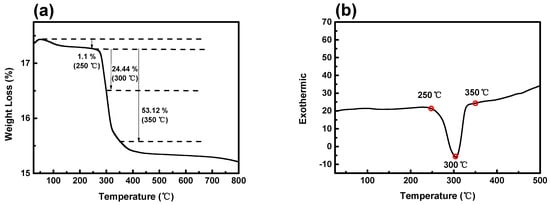
Figure 1.
(a,b) TGA-DSC profile of the NiCo2O4 sample as a function of temperatures.
3.2. Structural Properties of NiCo2O4 Active Materials
Figure 2 presents the results of the X-ray diffraction (XRD) analysis, depicting the crystal structure of the hydrothermally synthesized NiCo2O4 active materials. The diffraction peaks of the NiCo2O4 sample were observed at 2θ angles of 18.7°, 31.4°, 36.7°, 37.7°, 44.4°, 55.6°, 58°, 64.9°, and 77.3°. The peaks indicated the (111), (220), (311), (222), (400), (422), (511), (440), and (533) planes, respectively. The XRD pattern analysis revealed a spinel crystal structure (JCPDS No. 20-0781), with a preferential growth orientation along the (311) plane for the hydrothermally synthesized NiCo2O4 [23]. No discernible changes in crystal structure or phase were observed with varying annealing temperatures [24].
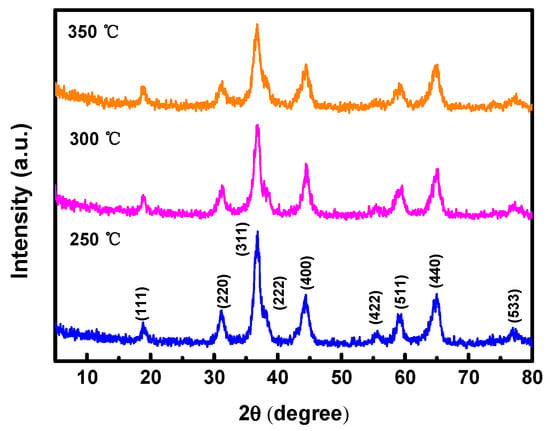
Figure 2.
XRD spectra of NiCo2O4 samples prepared by annealing at different temperatures.
The full width at half maximum (FWHM) of the primary diffraction peak decreased to 1.152 at 250 °C, 0.768 at 300 °C, and 0.288 at 350 °C. The crystallite size of the NiCo2O4 samples was calculated by substituting the FWHM value obtained from XRD data into Scherrer’s formula [25]. The calculated crystallite size at each annealing temperature increased by 7.6 nm at 250 °C, 11.4 nm at 300 °C, and 30.6 nm at 350 °C, indicating an enhancement in crystallinity with higher annealing temperatures.
Figure 3 illustrates the TEM analysis results of NiCo2O4 samples annealed from 250 °C to 350 °C. The top panel shows low-magnification TEM images and the scale bars are 100 nm. The middle panel displays the electron diffraction pattern (EDP) images, and the bottom panel presents magnified EDP images. The specimens fabricated by hydrothermal synthesis were polycrystals and, through EDP analysis, a ring pattern corresponding to the crystal growth orientation of each specimen was obtained. In the middle panel, the EDP illustrates the crystal orientation of NiCo2O4 with a white dashed line, while the crystal orientation of NiO is denoted by a yellow dashed line. The specimen annealed at 250 °C exhibited solely blurred diffraction spots corresponding to the (111) plane of NiO. In the 300 °C specimen, blurred spots corresponding to both the (111) and (200) planes were observed, but the shapes of the spots remained indistinct and could not be easily distinguished. In the 350 °C specimen, spots indicating the (111) and (200) planes were also present, but the diffraction spots of the (111) plane appeared more distinct compared to those at other temperatures. This indicates that crystalline NiO precipitated from the NiCo2O4 matrix during the annealing process at 350 °C. The TEM analysis results were consistent with the thermal properties previously described and chemical equation 2 of NiCo2O4.
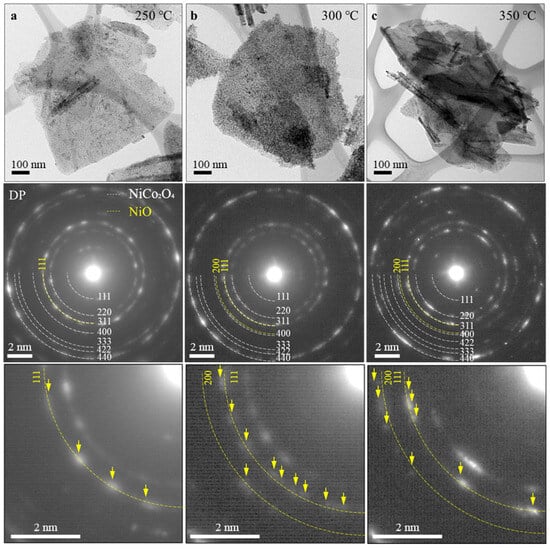
Figure 3.
TEM analysis results of NiCo2O4 samples annealed from 250 °C to 350 °C: (top panel) low-magnification TEM images, (middle panel) EDP images, and (bottom panel) magnified EDP images.
3.3. BET Analysis of NiCo2O4 Active Materials
Surface area and pore volume are acknowledged to be critical factors influencing the characteristics of capacitor materials. Brunauer–Emmett–Teller (BET) gas adsorption measurements were utilized to determine both BET and Barrett–Joyner–Halenda (BJH) factors [26].
As shown in Table 1, the pore size of NiCo2O4 at each annealing temperature was determined to be 3.6 nm at 250 °C, 4.0 nm at 300 °C, and 5.3 nm at 350 °C, indicating a mesoporous nature [27]. The surface area of the sample at each temperature was measured to be 258.4 m2/g at 250 °C, 129.7 m2/g at 300 °C, and 148.8 m2/g at 350 °C. Concurrently, the pore volume increased from 0.51 cm3/g to 0.77 cm3/g as the annealing temperature escalated from 250 °C to 350 °C. These findings affirm that, with the elevation in annealing temperature, the surface area decreases, while the pore volume and size comparatively increase. The results of the NiCo2O4 surface area analysis conducted through BET/BJH measurements are depicted in Figure 4. The BET/BJH hysteresis loop observed for each sample exhibits a type IV loop, indicative of the filling and emptying of mesopores through capillary condensation [28].

Table 1.
BET/BJH results of NiCo2O4 active materials according to various annealing temperatures.

Figure 4.
BET and BJH results for NiCo2O4 samples at different annealing temperatures: (a) 250 °C, (b) 300 °C, and (c) 350 °C.
3.4. Chemical Properties of NiCo2O4 Active Materials
Figure 5 presents the chemical analysis of NiCo2O4 active materials annealed at 350 °C. In Figure 5a, the comprehensive X-ray photoelectron spectroscopy (XPS) spectrum of NiCo2O4 reveals well-defined peaks corresponding to Ni 2p, Co 2p, O 1s, and C 1s. The presence of C 1s signifies carbon contamination introduced during experimental procedures or equipment usage. In Figure 5b, the Ni 2p spectrum of the sample at 350 °C is elaborated, revealing prominent peaks at 854.5 eV and 871.95 eV, corresponding to Ni 2p3/2 and Ni 2p1/2 states, with a separation of 17.45 eV. Each peak is accompanied by two shake-up satellite peaks at 861.1 eV and 879.5 eV. The peaks at 853.6 eV and 871.1 eV denote the Ni2+ state, while the peaks at 855.4 eV and 872.8 eV represent the Ni3+ state [29]. Two clearly identifiable peaks, Ni2+ and Ni3+, are observed on the Ni 2p spectrum. The spin-orbit splitting energy difference (ΔE = 2p1/2 − 3p3/2) was calculated to be 17.5 eV for Ni2+ 2p3/2 and 17.4 eV for Ni3+ 2p3/2 [30].
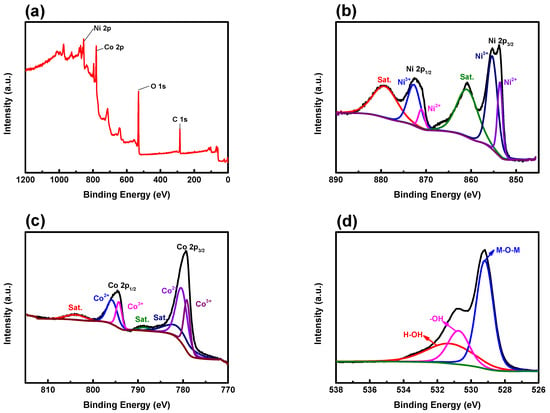
Figure 5.
XPS Spectrum of NiCo2O4 samples annealed at 350 °C: (a) full spectrum, (b) Ni 2p, (c) Co 2p, and (d) O 1s.
The Co 2p spectrum shown in Figure 5c exhibits two primary peaks at 779.85 eV and 794.9 eV, separated by 15.05 eV in the Co 2p3/2 and Co 2p1/2 states. Each main peak is succeeded by three shake-up satellite peaks at 782.6, 788.8, and 804.2 eV. The peaks at 779.2 eV and 794.3 eV correspond to the Co3+ state, while the peaks at 780.5 eV and 795.5 eV represent the Co2+ state. Figure 5d shows the O 1s spectrum featuring three distinct oxygen peaks. The primary peak of M-O-M is observed at 529.1 eV, signifying a metal-oxygen bond, while the -OH peak emerges at 530.7 eV, indicative of a multiple defect site with low oxygen coordination. The H-OH peak represents the physical and chemical bonds of residual moisture present on the material surface [31].
3.5. Morphological Properties of NiCo2O4 Electrodes
Figure 6 shows FE-SEM images of the surface morphology of NiCo2O4 electrodes grown through hydrothermal synthesis on nickel foam (Ni-foam). Figure 6a–c presents low-magnification views of the samples annealed at different temperatures. Well-established growth of NiCo2O4 active materials throughout the Ni-foam was confirmed. Figure 6d–f provides high-magnification images, unveiling intricate details of the surface morphology of NiCo2O4 active materials synthesized on the Ni-foam surface. At an annealing temperature of 250 °C, the electrodes grow in the form of nanopillars and nanowires. The surface shape undergoes deformation with an increase in annealing temperature. The structures at 300 °C and 350 °C exhibit nanosheet microstructures with a wavy, silk-like appearance [32]. Nanosheet arrays and porous nanostructures grown on Ni-foam promote charge transport and ion diffusion without binder blocks [33].
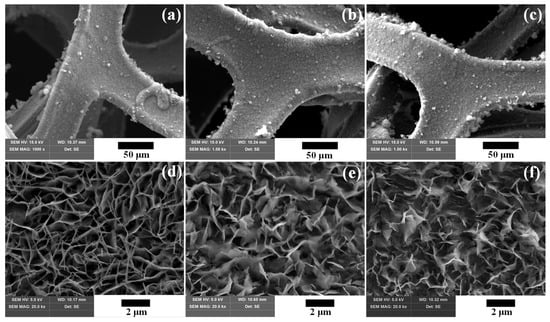
Figure 6.
High- and low-magnification FE-SEM images of NiCo2O4 electrode surfaces prepared by annealing at various temperatures: (a,d) 250 °C, (b,e) 300 °C, and (c,f) 350 °C.
3.6. Electrochemical Properties of NiCo2O4 Electrodes
A comprehensive investigation and analysis were conducted to explore the capacitance properties of three electrode samples prepared through hydrothermal synthesis, followed by annealing at different temperatures. Cyclic voltammetry (CV) data, collected over a potential range of 0 V to 0.6 V at various scan rates ranging from 10 mV to 50 mV, are summarized in Figure 7. The samples distinctly exhibit redox characteristics typical of pseudo-capacitors. An oxidation reaction occurs between 0.4 V and 0.55 V, followed by a reduction reaction between 0.2 V and 0.4 V. The observed magnitude of the current response indicates robust Faradaic response characteristics of battery-type electrode materials [34]. The Faraday reaction, which represents the interaction of electrical properties, can be expressed by the following chemical equation [35,36,37]:
NiCo2O4 + OH− → NiOOH + 2CoOOH + e−
CoOOH + OH− → CoO2 + H2O +e−
NiO + OH− → NiOOH + e−
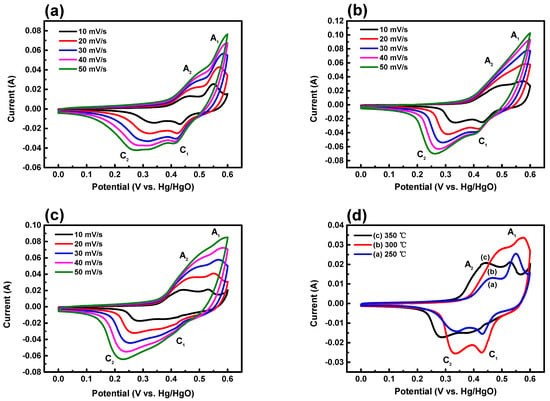
Figure 7.
CV profiles of NiCo2O4 electrodes annealed at different temperatures: (a) 250 °C, (b) 300 °C, (c) 350 °C, and (d) comparison of CV values at 10 mV.
A pair of redox peaks is observed at the NiCo2O4 electrodes, originating from a Faradaic reaction involving M-O/M-O-OH (where M represents Ni and Co ions) associated with the anion OH− [38]. The two pairs of redox current peaks correspond to the reversible reactions of Co2+/Co3+ and Ni2+/Ni3+ transitions [39]. The appearance of additional peaks, distinct from Ni2+/Ni3+ and Co2+/Co3+, in the CV plot at lower scan rates may be attributed to the presence of an oxygen-containing compound, NiO [40]. Two oxidation peaks, labeled A1 and A2, and reduction peaks, denoted C1 and C2, were identified [41,42]. With higher annealing temperatures, the dominance of the A2 peak over A1 and the prevalence of the C2 peak compared to C1 become more pronounced. This trend correlates with the NiO precipitation observed in the TEM images.
Electrochemical measurements were conducted using the galvanostatic charge–discharge (GCD) method on three electrodes under various current densities, while maintaining a limiting potential of 550 mV. The three graphs depicted in Figure 8 show consistent reversible patterns. During the charge–discharge process, a non-linear graph expressing the unique charge–discharge characteristics of a battery-type pseudo-capacitor was observed, rather than the typical linear curve seen with an electric double-layer capacitor (EDLC) [43]. The sample annealed at 250 °C exhibits an ideal graph for charging and discharging. The sample annealed at 350 °C displays a flat graph, requiring approximately 450 s for charging. However, during discharging, all the stored energy is released in about 150 s due to a rapid voltage drop. The specific capacitance is calculated using the following equation [44]:
C = (I × ∆t)/(m × ∆V)
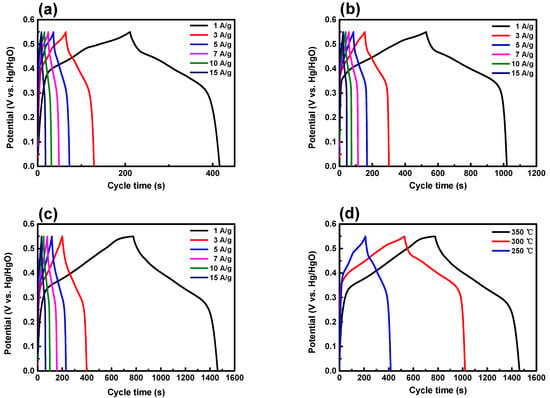
Figure 8.
GCD profiles of NiCo2O4 electrodes annealed at different temperatures: (a) 250 °C, (b) 300 °C, (c) 350 °C, and (d) comparison of GCD values in 1 A/g.
In this equation, C (F/g) represents the specific capacitance, I (A) is the current during the discharge process, ∆t (s) is the discharge time, ∆V (V) is the electromotive force, and m (g) is the mass of the active material. The specific capacitance of the NiCo2O4 electrode annealed at 250 °C was determined to be 371 F/g, 351 F/g, 330 F/g, 311 F/g, 287 F/g, and 248 F/g under varying current densities. Notably, there was a discernible decrease in specific capacitance with the escalation of current density. The reduction in capacity with rising current density and scanning speed can be attributed to the contact time with the active surface of the material and the extent of ionic contact [45]. The specific capacitance of the electrode annealed at 300 °C, identified by the exothermic reaction and crystallization temperature in DSC analysis (in Figure 1), was calculated to be 893 F/g, 798 F/g, 750 F/g, 710 F/g, 662 F/g, and 605 F/g at respective current densities. The specific capacitance of the NiCo2O4 electrode annealed at 350 °C, where the exothermic reaction and crystallization reached a stable state, was determined to be 1254 F/g, 1075 F/g, 1038 F/g, 987 F/g, 898 F/g, and 866 F/g for each corresponding current density. This GCD analysis confirms that the annealing temperature of 350 °C serves as a significant factor in enhancing the charge–discharge time of the NiCo2O4 electrode. The energy density and power density values were calculated using the equation E = 1/2·(C·V2), where E represents energy density, C is the specific capacitance, and V is the voltage [46]. The NiCo2O4 electrode annealed at 250 °C displayed an energy density of 56 W/g, while the electrode annealed at 300 °C exhibited a density of 135 W/g, and the electrode annealed at 350 °C demonstrated a density of 188 W/g. The power density of the electrodes was determined with the formula P = E/Δt, where P denotes power density, E is energy density, and Δt is the discharge time [47]. All three NiCo2O4 electrodes (250 °C, 300 °C, 350 °C) exhibited a power density of 0.275 W/g.
Figure 9a illustrates Nyquist plots obtained from electrochemical impedance spectroscopy (EIS), which measures impedance. The real impedance (Z’) is mathematically expressed as Z’ = Rs + Rct, where Rs denotes electrolyte resistance and Rct signifies charge transfer resistance of electrode [48]. EIS measurements offer valuable insights into the resistance characteristics of each electrode. The NiCo2O4 electrode annealed at 250 °C demonstrates an Rs value of 0.86 Ω. The electrodes annealed at 300 °C and 350 °C exhibit Rs values of 0.57 Ω and 0.60 Ω, respectively. The Rct values were determined through the fitting process of the equivalent circuit using the equation Rs + Cd1/(Rct + W) + Cps. The presented equivalent circuit consists of electrode internal resistance (Rs), Faraday charge transfer resistance (Rct), diffusion resistance (W), Faradaic pseudocapacitance (Cps), and a constant phase element (Cdl) [49]. The Rct of the electrode annealed at 300 °C decreased to 1.018 Ω, while the Rct value for the electrode annealed at the higher temperature of 350 °C showed a slight increase to 1.348 Ω. The Nyquist plot deviates from the typical semicircular shape, demonstrating a relatively linear configuration. This suggests that the oxidation-substrate interface resistance is minimized, nearly eliminating the Nyquist plot [50]. These results mean that the interfacial resistance between the Ni-foam and NiCo2O4 active material is minimized, and suggest that the contact resistance problem can be solved by adding HMT without using a binder.

Figure 9.
(a) EIS analysis of NiCo2O4 electrodes, (b) specific capacitance at various current densities, and (c) capacitive retention as a function of cycle number.
In Figure 9b, the variation in capacitance per current density is presented. All three electrodes consistently demonstrated a gradual decrease in capacitance with increasing current density. The electrode sample annealed at 350 °C exhibited a higher rate of capacitance decrease compared to the one annealed at 250 °C. In Figure 9c, the capacitance retention rates for each sample were measured at a scan rate of 7 A/g. The electrode sample annealed at 250 °C exhibited an 88% retention rate, while the 300 °C sample showed a retention rate of 75%. The sample annealed at 350 °C demonstrated a retention rate of 63%.
4. Conclusions
In this study, we aimed to enhance the capacitance of NiCo2O4 electrodes for supercapacitors using a porous Ni-foam support. The synthesis process involved a hydrothermal method for growing NiCo2O4 on Ni-foam, with the addition of HMT to address resistance issues arising from binders during synthesis. NiCo2O4 samples underwent post-heat treatment at varying temperatures of 250 °C, 300 °C, and 350 °C. The impact of annealing temperatures on the structural and electrochemical properties of NiCo2O4 samples was analyzed. The thermal properties revealed that weight loss due to water evaporation occurred post 100 °C, stabilizing beyond 450 °C. The weight loss rates for the samples subjected to heat treatment at temperatures of 250 °C, 300 °C, and 350 °C were 1.1%, 24.4%, and 53.1%, respectively. The XRD pattern confirmed the NiCo2O4 active material, which exhibited a spinel structure, and the TEM results highlighted sharper diffraction spots on the NiO (111) plane for the sample annealed at 350 °C. The FE-SEM image shows the formation of nanopillar and nanowire shapes at an annealing temperature of 250 °C. Subsequently, this surface morphology transformed into a nanosheet microstructure with a silk-like appearance at 300 °C and 350 °C. The analysis of CV results revealed that the NiCo2O4 electrodes, prepared through hydrothermal synthesis, exhibited typical redox characteristics indicative of a pseudo-capacitor. Moreover, it demonstrated Faraday response properties suitable for application as a battery-type electrode material. Despite a general decrease in the specific capacitance with increasing current density across all samples, the NiCo2O4 electrode annealed at 350 °C exhibited the highest specific capacitance. However, the capacity retention rate demonstrated a decline, reaching 88% at 250 °C, 75% at 300 °C, and 63% at 350 °C.
Author Contributions
Conceptualization, S.-H.L. and D.H.; methodology, C.-S.S. and Y.-G.S.; formal analysis, S.-H.L. and J.P.; investigation, S.-H.L., J.P., and H.-J.C.; resources, C.-S.S. and Y.-G.S.; writing—original draft preparation, S.-H.L. and D.H.; writing—review and editing, S.-H.L., C.-S.S., Y.-G.S., and D.H.; visualization, S.-H.L., J.P., and H.-J.C.; supervision, C.-S.S. and Y.-G.S.; project administration, D.H.; funding acquisition, C.-S.S. and D.H. All authors have read and agreed to the published version of the manuscript.
Funding
This work was supported by the National Research Foundation of Korea (NRF) grant funded by the Korea government (MSIT) (No. NRF-2018R1A5A1025594) and was supported by “Regional Innovation Strategy (RIS)” through the National Research Foundation of Korea (NRF) funded by the Ministry of Education (MOE) (No. 2023RIS-007).
Data Availability Statement
Data are contained within the article.
Conflicts of Interest
The authors declare no conflict of interest.
References
- Kuhns, R.J.; Shaw, G.H. Peak Oil and Petroleum Energy Resources. In Navigating the Energy Maze; Springer: Cham, Switzerland, 2018; pp. 53–63. [Google Scholar] [CrossRef]
- Withagen, C. Pollution and exhaustibility of fossil fuels. Resour. Energy Econ. 1994, 16, 235–242. [Google Scholar] [CrossRef]
- Dincer, I. Renewable energy and sustainable development: A crucial review. Renew. Sust. Energ. Rev. 2000, 4, 157–175. [Google Scholar] [CrossRef]
- Midilli, A.; Dincer, I.; Ay, M. Green energy strategies for sustainable development. Energy Policy 2006, 34, 3623–3633. [Google Scholar] [CrossRef]
- Rajeshkhanna, G.; Umeshbabu, E.; Justin, P.; Rao, G.R. In situ fabrication of porous festuca scoparia-like Ni0.3Co2.7O4 nanostructures on Ni-foam: An efficient electrode material for supercapacitor applications. Int. J. Hydrogen Energy 2015, 40, 12303–12314. [Google Scholar] [CrossRef]
- Liu, C.; Li, F.; Ma, L.P.; Cheng, H.M. Advanced materials for energy storage. Adv. Mater. 2010, 22, E28–E62. [Google Scholar] [CrossRef] [PubMed]
- Minakshi, M.; Mitchell, D.R.G.; Jones, R.T.; Pramanik, N.C.; Jean-Fulcrand, A.; Garnweitner, G. A Hybrid Electrochemical Energy Storage Device Using Sustainable Electrode Materials. ChemistrySelect 2020, 5, 1597–1606. [Google Scholar] [CrossRef]
- Wang, H.; Casalongue, H.S.; Liang, Y.; Dai, H. Ni(OH)2 Nanoplates Grown on Graphene as Advanced Electrochemical Pseudocapacitor Materials. J. Am. Chem. Soc. 2010, 132, 7472–7477. [Google Scholar] [CrossRef]
- Krishnamoorthy, K.; Pazhamalai, P.; Kim, S.J. Ruthenium sulfide nanoparticles as a new pseudocapacitive material for supercapacitor. Electrochim. Acta 2017, 227, 85–94. [Google Scholar] [CrossRef]
- Abdelhamid, M.E.; O’Mullane, A.P.; Snook, G.A. Storing energy in plastics: A review on conducting polymers & their role in electrochemical energy storage. RSC Adv. 2015, 5, 5. [Google Scholar] [CrossRef]
- Augustyn, V.; Simon, P.; Dunn, B. Pseudocapacitive oxide materials for high-rate electrochemical energy storage. Energy Environ. Sci. 2013, 7, 1597–1614. [Google Scholar] [CrossRef]
- Hasegawa, G.; Kitada, A.; Kawasaki, S.; Kanamori, K.; Nakanishi, K.; Kobayashi, Y.; Kageyama, H.; Abe, T. Impact of Electrolyte on Pseudocapacitance and Stability of Porous Titanium Nitride (TiN) Monolithic Electrode. J. Electrochem. Soc. 2015, 162, A77–A85. [Google Scholar] [CrossRef]
- Chen, R.; Yu, M.; Sahu, R.P.; Puri, I.K.; Zhitomirsky, I. The Development of Pseudocapacitor Electrodes and Devices with High Active Mass Loading. Adv. Energy Mater. 2020, 10, 1903848. [Google Scholar] [CrossRef]
- Si, W.; Yan, C.; Chen, Y.; Oswald, S.; Han, L.; Schmidt, O.G. On chip, all solid-state and flexible micro-supercapacitors with high performance based on MnOx/Au multilayers. Energy Environ. Sci. 2013, 6, 3218–3223. [Google Scholar] [CrossRef]
- Peng, H.; Cui, S.; Xie, X.; Wei, G.; Sun, K.; Ma, G.; Lei, Z. Binary tungsten-molybdenum oxides nanoneedle arrays as an advanced negative electrode material for high performance asymmetric supercapacitor. Electrochim. Acta 2019, 322, 134759. [Google Scholar] [CrossRef]
- Ahirrao, D.J.; K, M.; Jha, N. Bulk to nanostructured vanadium pentaoxide-nanowires (V2O5-NWs) for high energy density supercapacitors. AIP Conf. Proc. 2018, 1942, 140066. [Google Scholar] [CrossRef]
- Zhan, J.; Cai, M.; Zhang, C.; Wang, C. Synthesis of mesoporous NiCo2O4 fibers and their electrocatalytic activity on direct oxidation of ethanol in alkaline media. Electrochim. Acta 2015, 154, 70–76. [Google Scholar] [CrossRef]
- Packiaraj, R.; Devendran, P.; Venkatesh, K.S.; Mahendraprabhu, K.; Nallamuthu, N. Unveiling the structural, charge density distribution and supercapacitor performance of NiCo2O4 nano flowers for asymmetric device fabrication. J. Energy Storage 2021, 34, 102029. [Google Scholar] [CrossRef]
- Salleh, N.A.; Kheawhom, S.; Mohamad, A.A. Characterizations of nickel mesh and nickel foam current collectors for supercapacitor application. Arab. J. Chem. 2020, 13, 6838–6846. [Google Scholar] [CrossRef]
- Zhang, J.; Chen, Y.; Chu, R.; Jiang, H.; Zeng, Y.; Zhang, Y.; Huang, N.M.; Guo, H. Pseudocapacitive P-doped NiCo2O4 microspheres as stable anode for lithium ion batteries. J. Alloys Compd. 2019, 787, 1051–1062. [Google Scholar] [CrossRef]
- Chi, B.; Li, J.; Han, Y.; Chen, Y. Effect of temperature on the preparation and electrocatalytic properties of a spinel NiCo2O4/Ni electrode. Int. J. Hydrogen Energy 2004, 29, 605–610. [Google Scholar] [CrossRef]
- Wang, Z.-Y.; Chang, H.-W.; Tsai, Y.-C. Synthesis of Bimetallic Ni-Co Phosphide Nanosheets for Electrochemical Non-Enzymatic H2O2 Sensing. Nanomaterials 2023, 13, 66. [Google Scholar] [CrossRef] [PubMed]
- Cabo, M.; Pellicer, E.; Rossinyol, E.; Castell, O.; Suriñach, S.; Baró, M.D. Mesoporous NiCo2O4 Spinel: Influence of Calcination Temperature over Phase Purity and Thermal Stability. Cryst. Growth Des. 2009, 9, 4814–4821. [Google Scholar] [CrossRef]
- Guo, W.; Wu, Y.; Tian, Y.; Lian, X.; Li, J.; Wang, S. Hydrothermal Synthesis of NiCo2O4/CoMoO4 Nanocomposite as a High-Performance Electrode Material for Hybrid Supercapacitors. ChemElectroChem 2019, 6, 4645–4652. [Google Scholar] [CrossRef]
- Zhu, Y.; Ji, X.; Wu, Z.; Song, W.; Hou, H.; Wu, Z.; He, X.; Chen, Q.; Banks, C.E. Spinel NiCo2O4 for use as a high-performance supercapacitor electrode material: Understanding of its electrochemical properties. J. Power Sources 2014, 267, 888–900. [Google Scholar] [CrossRef]
- Lee, D.; Choi, Y.; Kim, M.C.; Ji, H.; Shin, H.-C.; Kim, K.H. Design and mechanism study of multi-phase materials for cathodes in high-performance supercapacitors. J. Energy Storage 2022, 52, 104831. [Google Scholar] [CrossRef]
- Rahman, M.M.; Muttakin, M.; Pal, A.; Shafiullah, A.Z.; Saha, B.B. A Statistical Approach to Determine Optimal Models for IUPAC-Classified Adsorption Isotherms. Energies 2019, 12, 4565. [Google Scholar] [CrossRef]
- Yahia, M.B.; Torkia, Y.B.; Knani, S.; Hachicha, M.A.; Khalfaoui, M.; Lamin, A.B. Models for Type VI Adsorption Isotherms from a Statistical Mechanical Formulation. Adsorp. Sci. Technol. 2013, 31, 341–357. [Google Scholar] [CrossRef]
- Yewale, M.A.; Kadam, R.A.; Kaushik, N.K.; Vattikuti, S.V.P.; Lingamdinne, L.P.; Koduru, J.R.; Shin, D.K. Hydrothermally synthesized microrods and microballs of NiCo2O4 for supercapacitor application. Ceram. Int. 2022, 48, 21996–22005. [Google Scholar] [CrossRef]
- Gonzalez-Elipe, A.R.; Holgado, J.P.; Alvarez, R.; Munuera, G. Use of Factor Analysis and XPS To Study Defective Nickel Oxide. J. Am. Chem. Soc. 1992, 92, 3080–3086. [Google Scholar] [CrossRef]
- Wang, Z.; Su, H.; Liu, F.; Chu, X.; Yan, C.; Gu, B.; Huang, H.; Yang, T.; Chen, N.; Han, Y.; et al. Establishing highly-efficient surface faradaic reaction in flower-like NiCo2O4 nano-/micro-structures for next-generation supercapacitors. Electrochim. Acta. 2019, 307, 302–309. [Google Scholar] [CrossRef]
- Yuan, C.; Li, J.; Hou, L.; Zhang, X.; Shen, L.; Lou, X.W.D. Ultrathin Mesoporous NiCo2O4 Nanosheets Supported on Ni Foam as Advanced Electrodes for Supercapacitors. Adv. Funct. Mater. 2012, 22, 4592–4597. [Google Scholar] [CrossRef]
- Chen, H.; Hu, L.; Chen, M.; Yan, Y.; Wu, L. Nickel–Cobalt Layered Double Hydroxide Nanosheets for High-performance Supercapacitor Electrode Materials. Adv. Funct. Mater. 2013, 24, 934–942. [Google Scholar] [CrossRef]
- Jiang, S.; Sun, Y.; Dai, H.; Ni, P.; Lu, W.; Wang, Y.; Li, Z.; Li, Z. A facile enhancement in battery-type of capacitive performance of spinel NiCo2O4 nanostructure via directly tuning thermal decomposition temperature. Electrochim. Acta 2016, 191, 364–374. [Google Scholar] [CrossRef]
- Liu, X.; Shi, S.; Xiong, Q.; Li, L.; Zhang, Y.; Tang, H.; Gu, C.; Wang, X.; Tu, J. Hierarchical NiCo2O4@NiCo2O4 core/shell nanoflake arrays as high-performance supercapacitor materials. ACS Appl. Mater. Interfaces 2013, 5, 8790–8795. [Google Scholar] [CrossRef] [PubMed]
- Yan, D.; Wang, W.; Luo, X.; Chen, C.; Zeng, Y.; Zhu, Z. NiCo2O4 with oxygen vacancies as better performance electrode material for supercapacitor. J. Chem. Eng. 2018, 334, 864–872. [Google Scholar] [CrossRef]
- Kim, S.-I.; Lee, J.-S.; Ahn, H.-J.; Song, H.-K.; Jang, J.-H. Facile route to an efficient NiO supercapacitor with a three-dimensional nanonetwork morphology. ACS Appl. Mater. Interfaces 2013, 5, 1596–1603. [Google Scholar] [CrossRef]
- Yu, L.; Zhang, G.; Yuan, C.; Lou, X.W.D. Hierarchical NiCo2O4@MnO2 core–shell heterostructured nanowire arrays on Ni foam as high-performance supercapacitor electrodes. R. Soc. Chem. 2013, 49, 137–139. [Google Scholar] [CrossRef]
- Wang, H.-W.; Hu, Z.-A.; Chang, Y.-Q.; Chen, Y.-L.; Wu, H.-Y.; Zhang, Z.-Y.; Yang, Y.-Y. Design and synthesis of NiCo2O4–reduced graphene oxide composites for high performance supercapacitors. J. Mater. Chem. 2011, 21, 10504–10511. [Google Scholar] [CrossRef]
- Wang, H.; Holt, C.M.B.; Li, Z.; Tan, X.; Amirkhiz, B.S.; Xu, Z.; Olsen, B.C.; Stephenson, T.; Mitlin, D. Graphene-nickel cobaltite nanocomposite asymmetrical supercapacitor with commercial level mass loading. Nano Res. 2012, 5, 605–617. [Google Scholar] [CrossRef]
- Barmi, M.J.; Minakshi, M. Tuning the Redox Properties of the Nanostructured CoMoO4 Electrode: Effects of Surfactant Content and Synthesis Temperature. Chempluschem 2016, 81, 964–977. [Google Scholar] [CrossRef]
- Samal, R.; Dash, B.; Sarangi, C.K.; Sanjay, K.; Subbaiah, T.; Senanayake, G.; Minakshi, M. Influence of Synthesis Temperature on the Growth and Surface Morphology of Co3O4 Nanocubes for Supercapacitor Applications. Nanomaterials 2017, 7, 356. [Google Scholar] [CrossRef] [PubMed]
- Akinwolemiwa, B.; Peng, C.; Chen, G.Z. Redox Electrolytes in Supercapacitors. J. Electrochem. Soc. 2015, 162, A5054–A5059. [Google Scholar] [CrossRef]
- Gong, L.; Xu, M.; Ma, R.; Han, Y.; Xu, H.; Shi, G. High-performance supercapacitor based on MOF derived porous NiCo2O4 nanoparticle. Sci. China Technol. Sci. 2020, 63, 1470–1477. [Google Scholar] [CrossRef]
- Siwatch, P.; Sharma, K.; Tripathi, S.K. Facile synthesis of NiCo2O4 quantum dots for asymmetric supercapacitor. Electrochim. Acta. 2020, 329, 135084. [Google Scholar] [CrossRef]
- Zhang, H.; Xiao, D.; Li, Q.; Ma, Y.; Yuan, S.; Xie, L.; Chen, C.; Lu, C. Porous NiCo2O4 nanowires supported on carbon cloth for flexible asymmetric supercapacitor with high energy density. J. Energy Chem. 2018, 27, 195–202. [Google Scholar] [CrossRef]
- Wang, Q.; Wang, X.; Xu, J.; Ouyang, X.; Hou, X.; Chen, D.; Wang, R.; Shen, G. Flexible coaxial-type fiber supercapacitor based on NiCo2O4 nanosheets electrodes. Nano Energy 2014, 8, 44–51. [Google Scholar] [CrossRef]
- Salarizadeh, P.; Askari, M.B.; Seifi, M.; Rozati, S.M.; Eisazadeh, S.S. Pristine NiCo2O4 nanorods loaded rGO electrode as a remarkable electrode material for asymmetric supercapacitors. Mater. Sci. Semicond. 2020, 114, 105078. [Google Scholar] [CrossRef]
- Ding, R.; Qi, L.; Jia, M.; Wang, H. Facile and large-scale chemical synthesis of highly porous secondary submicron/micron-sized NiCo2O4 materials for high-performance aqueous hybrid AC-NiCo2O4 electrochemical capacitors. Electrochimi. Acta 2013, 107, 494–502. [Google Scholar] [CrossRef]
- Allison, A.; Andreas, H.A. Minimizing the Nyquist-plot semi-circle of pseudocapacitive manganese oxides through modification of the oxide-substrate interface resistance. J. Power Sources 2019, 426, 93–96. [Google Scholar] [CrossRef]
Disclaimer/Publisher’s Note: The statements, opinions and data contained in all publications are solely those of the individual author(s) and contributor(s) and not of MDPI and/or the editor(s). MDPI and/or the editor(s) disclaim responsibility for any injury to people or property resulting from any ideas, methods, instructions or products referred to in the content. |
© 2023 by the authors. Licensee MDPI, Basel, Switzerland. This article is an open access article distributed under the terms and conditions of the Creative Commons Attribution (CC BY) license (https://creativecommons.org/licenses/by/4.0/).